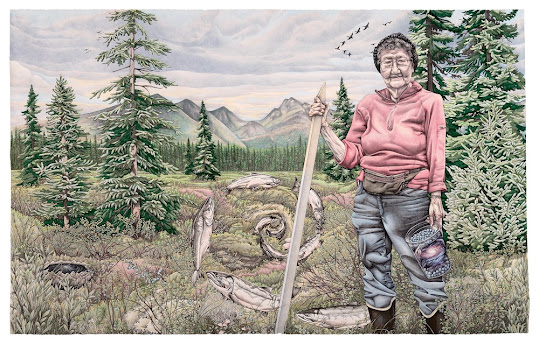Text and images require permission.
Please consider attending the above Zoom event. You can RSVP here until the the Zoom room reaches capacity, then it will be streamed on YouTube and Facebook. The event will be presented by Social and Public Art Resource Center (SPARC) in Los Angeles and features
work and testimonies of 20 artists, community organizers and activists. It debuts with a curatorial walk-through on Zoom on Saturday, February 27th, 4pm PST.
The event announcement notes "Alaska is warming twice as fast as the rest of the world, and climate change impacts range from melting permafrost releasing methane and carbon dioxide into the atmosphere, infrastructure eroding into the ocean, compromised survival of animal species, and changing subsistence patterns affecting food security. Changes in Alaska’s landscape have a global impact. Why We Won’t Just Leave: What Alaska is Telling the World About Climate Change is a virtual exhibition curated by Lindsay Carron [ . . . ] that highlights the responses of Alaskans to their rapidly changing environment. This exhibition delivers messages that are key for us all if we are to reverse climate catastrophe and cultivate a healthy, vibrant future for generations to come. Why We Won’t Just Leave features portraits, paintings, photography, stories, and video profiles of 20 artists, activists, researchers and community organizers responding to climate change in Alaska. From activists delivering testimonies in D.C. and artists revealing truth with beauty, to scientists studying methane released from melting permafrost, Alaska has a message for the world."
I found curator Lindsay Carron's work in an interview at American Federation of Teachers' (AFT) sharemylesson blog, and asked for permission to include part of it below along with five of her art pieces. The site about her ART FOR HUMANITY : ART FOR THE EARTH notes "She travels to remote areas of the planet to document wild lands and human relationship to them. Her intricate ink drawings offer viewers an opportunity to connect to their own wild hearts. [ . . . . ] Carron has empowered communities with murals, portraits and arts education in Kenya, Mexico, and Alaska." She has served as an "artist in residence with US Fish and Wildlife Service" and "partnered with [ . . . ] The Whale Museum of San Juan Island."
The interview, a Kindred Spirits guest post, notes:
"KS [Kindred Spirits]: Sometimes when considering the toll humans have taken on the environment, when cataloging damage to land and sea, it is easy to feel overwhelmed or as if one person can’t make a difference. Do you ever feel this way? How would you advise others to push through such feelings?"
"[Lindsay Carron]: All the time! Yet my experiences have taught me that even through the greatest destruction, life persists. Nature has an incredible way of remaking herself and persevering, just as humans do. My greatest lessons have been from the simplest experiences in nature. For instance, while traveling with a group of artists in Kenya, we hiked outside a remote Maasai village in the middle of the desert. We came upon a field that was literally shimmering in the low sunlight. As we approached, to my horror, the shimmering was coming from the light on thousands of plastic bags caught on branches of shrubs blowing in the wind. So the next morning, we decided to simply start picking up the trash that was all around us on the ground. Within minutes, the kids of the village caught on, and joined in the new fun game of picking up trash with the mzungus. Instead of being solely devastated by the reality, we took action, and it caught on! Home in Los Angeles this week, I rescued a tiny baby bird, still featherless and completely helpless, that had fallen from a nest in high winds. It cracked my heart wide open, put a halt to any other work I may have been doing, and tamed my focus for that night and the following day on the survival of that tiny being. The bird survived, and I was left with the simple lesson that all life matters. So when I feel debilitated from the weight of the devastation of our environments, I remember to simply do the kindest thing in the moment. It doesn’t have to be a big, heroic feat, but sometimes it may be. Environmentalism is not a competition. I learned through both of these experiences to come back to the present moment and the immediate environment and put my skills to work. I use my unique talents and gifts to sing my soul alive. Innately, I begin to see that from this state of being I impact my environment around me in positive ways and begin to see the magic that is present even in the destruction."
Five of Lindsay Carron's art pieces are below:
 |
Tundra Woman (Yup’ik Eskimo Elder Sophie Sakar Berry Picking on Alaskan Tundra) Ink and Colored Pencil on Paper, 4.5 x 7 feet 2019 |
 |
North 1.3: The Gateway Ink and Colored Pencil on Vintage 1952 Alaska Topographic Map 23 x 30in |
 |
Raven Ink and Gouache on Paper, 12 x 12″ 2017 |
 |
North 3.1: Medicine Ink and Colored Pencil on Vintage 1951 Alaska Topographic Map 23 x 30in |
 |
| “The Arctic Miracle of Life” 2017 Arctic National Wildlife Refuge Featuring Betty Brower and Isaac Akootchook of Kaktovik |

No comments:
Post a Comment